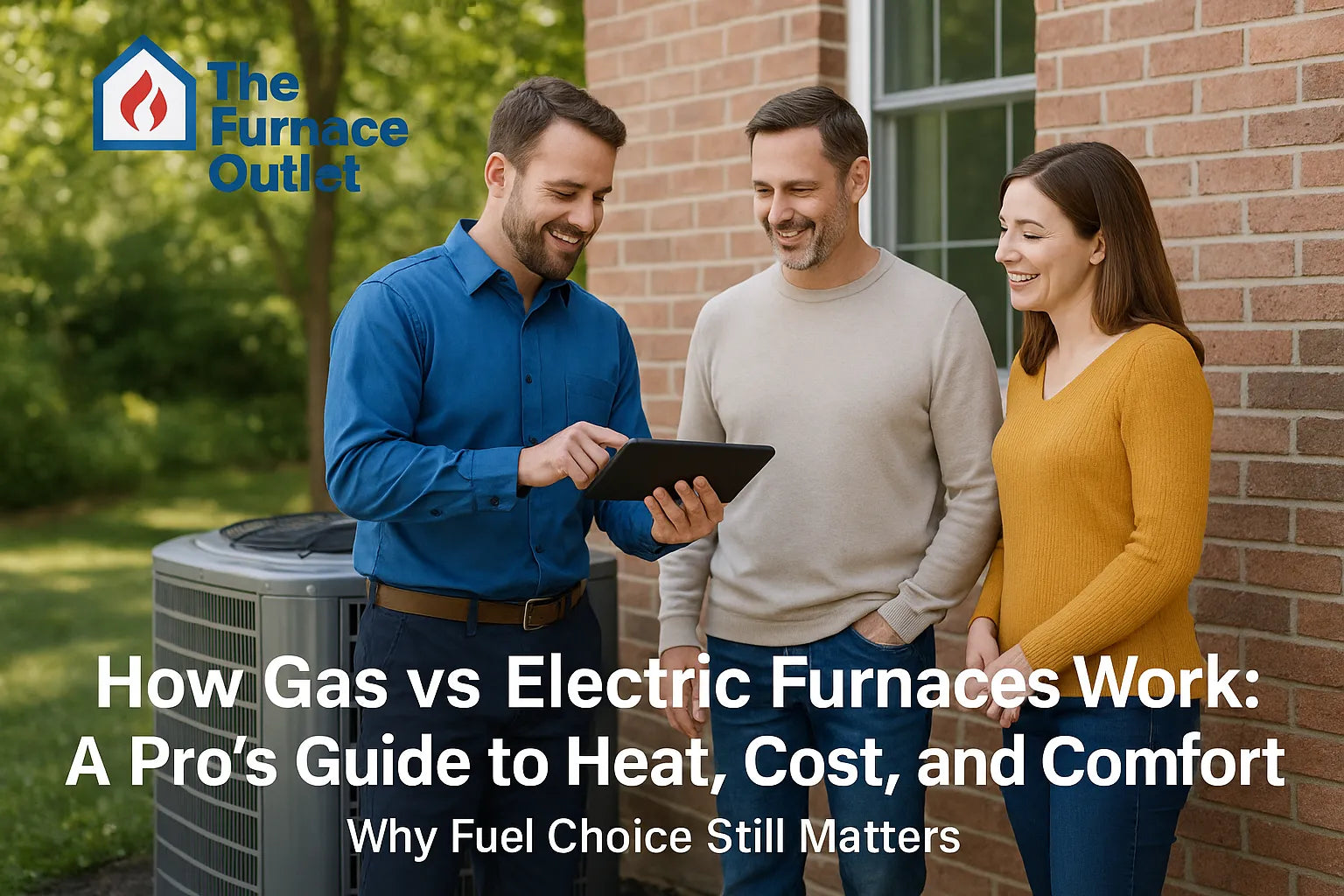Why Fuel Choice Still Matters in 2025
Natural-gas prices may be 60-70 % lower per MMBtu than grid electricity in most U.S. cold-weather markets, yet electrification incentives and renewable power mandates are shifting the balance fast. Knowing how each furnace creates heat clarifies when paying more per kilowatt-hour (kWh) might still make sense, like in milder Zones 1-2, where runtime hours stay low. Pros start with local utility rates, Manual J load, and lifecycle cost modeling, then layer in ventilation codes and rebate eligibility. See our Design Center for quick-calc spreadsheets that plug in today’s rates.
Inside a Gas Furnace: From Thermostat Call to Flue
The gas workflow is precise, safety-checked, and fast-acting:
graph LR
A[Thermostat] --> B(Draft Inducer)
B --> C(Pressure Switch OK)
C --> D(Igniter/Pilot)
D --> E(Burners Lit)
E --> F(Heat Exchanger)
F --> G(Blower ON)
G --> H(Conditioned Air to Ducts)
E --> I(Flue Gases Exhausted)
That draft inducer proves the flue is clear before the hot-surface igniter sparks, preventing back-drafting. Modern 90 %-plus AFUE units add a secondary stainless exchanger to reclaim latent heat from water vapor, practically squeezing every BTU before exhaust. Replace failed igniters with factory parts available under Furnaces – All; mismatched resistance values shorten lifespan.
Verify manifold pressure (3.5 in. w.c. nat gas) after every gas valve swap—those few tenths make or break efficiency.
Inside an Electric Furnace: Sequencers, Coils, Clean Heat
An electric furnace is simpler, no gas lines, no venting. When the contactor pulls in, sequencers stage each 5-kW nichrome coil to avoid a 100-amp inrush. Air moves across glowing elements just like a giant toaster, hitting the supply plenum within seconds. Because there’s zero stack loss, nameplate AFUE is effectively 100 %. Pair electric furnaces with Air Handlers or plug-and-play Package Units in tight closets where flues are impossible.
High-static duct runs can roast elements; keep external static ≤ 0.5 in. w.c. or add a PSC-to-ECM blower kit.
AFUE vs Real Bills: Making Sense of the Math
Annual Fuel Utilization Efficiency (AFUE) tells what fraction of input energy becomes usable heat inside the house. A 95 % gas unit wastes 5 % up the flue; an electric furnace wastes zero on site, but generation losses at the power plant can exceed 60 %. Convert AFUE into dollars by multiplying input BTU by local $/therm or $/kWh, then dividing by delivered heat. Our free calculator inside the Help Center factors in seasonal duty cycles so you can compare apples to apples.
Heating Dynamics: Temperature Rise, CFM, and Comfort
Gas furnaces routinely deliver a 40–70 °F temperature rise, blasting warm air fast—ideal when outdoor temps dip below 20 °F. Electric models trend 25–50 °F, which feels gentler but also lengthens runtime. For high ceilings or drafty envelopes, prioritize higher BTU/h output; for tight, spray-foamed homes, even a 15 °F rise may suffice. Always cross-check blower CFM against rise to keep heat-exchanger temps under limit-switch thresholds.
Total Cost of Ownership by Climate Zone
Installation on a gas line and PVC vent adds $1 k–$2 k upfront, yet the 15-year fuel savings in Zones 4–7 can dwarf that quickly. Conversely, an electric furnace can be on the wall tomorrow for half the labor, but monthly bills skyrocket where electric rates top $0.15/kWh. Hybrid dual-fuel packaged units blend both: mild-weather heat pump, sub-freezing gas backup—browse ready-made combos in R32 Residential Dual-Fuel Packages.
Safety & Maintenance: Combustion vs Resistance
Gas brings flame rollout, CO leaks, and condensate acidity into the checklist, hence annual combustion analysis and heat-exchanger inspection. Electric units dodge combustion risks but demand vigilant element cleaning; dust can glow red and trip high limits. Always kill breaker power (two-pole, HACR rated) before pulling elements. Replacement kits ship under Accessories with ceramic bushings pre-wired for 240 V.
Environmental Impact & Grid Readiness
Electrification slashes onsite emissions to zero, crucial for tight urban codes. Yet source emissions depend on your grid’s fuel mix. In renewably rich markets (hydro, wind, solar), electric furnaces rival the carbon footprint of high-eff gas—but in coal-heavy grids they may double it. If carbon is your metric, consider pairing a variable-speed heat pump with an electric coil backup: browse R-32 Heat Pump Systems for low-GWP refrigerant options.
Sizing & Duct Considerations: Getting Manual J Right
Oversizing a gas furnace can trigger short-cycling; oversizing electric coils can pop breakers. Calculate peak load with ACCA Manual J, de-rate for altitude, then choose the next size up only if ducts can handle the CFM. Need a second opinion? Our engineers review uploads via Contact Us. Turnaround is 24 hours for pros.
Future-Proofing: Dual-Fuel, Modulating, & Smart Controls
Utility rates fluctuate; your furnace shouldn’t lock you into a bad bet. Dual-fuel and modulating gas models integrate with Wi-Fi stats that auto-switch fuels by outdoor-air temp or rate signals, shaving 10–20 % off annual spend. For retrofit simplicity, see Commercial Packaged Gas/Electric Units factory-charged, crane-ready, BACnet-friendly.
Want help picking the right furnace for your home? Browse proven models at The Furnace Outlet.







